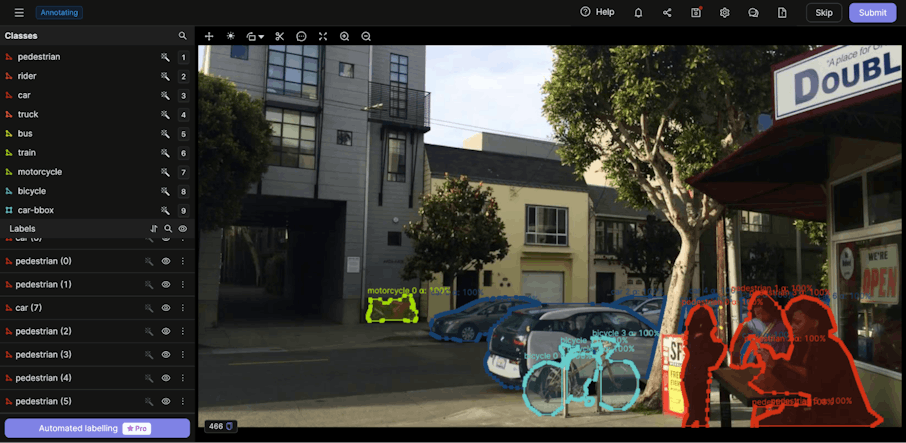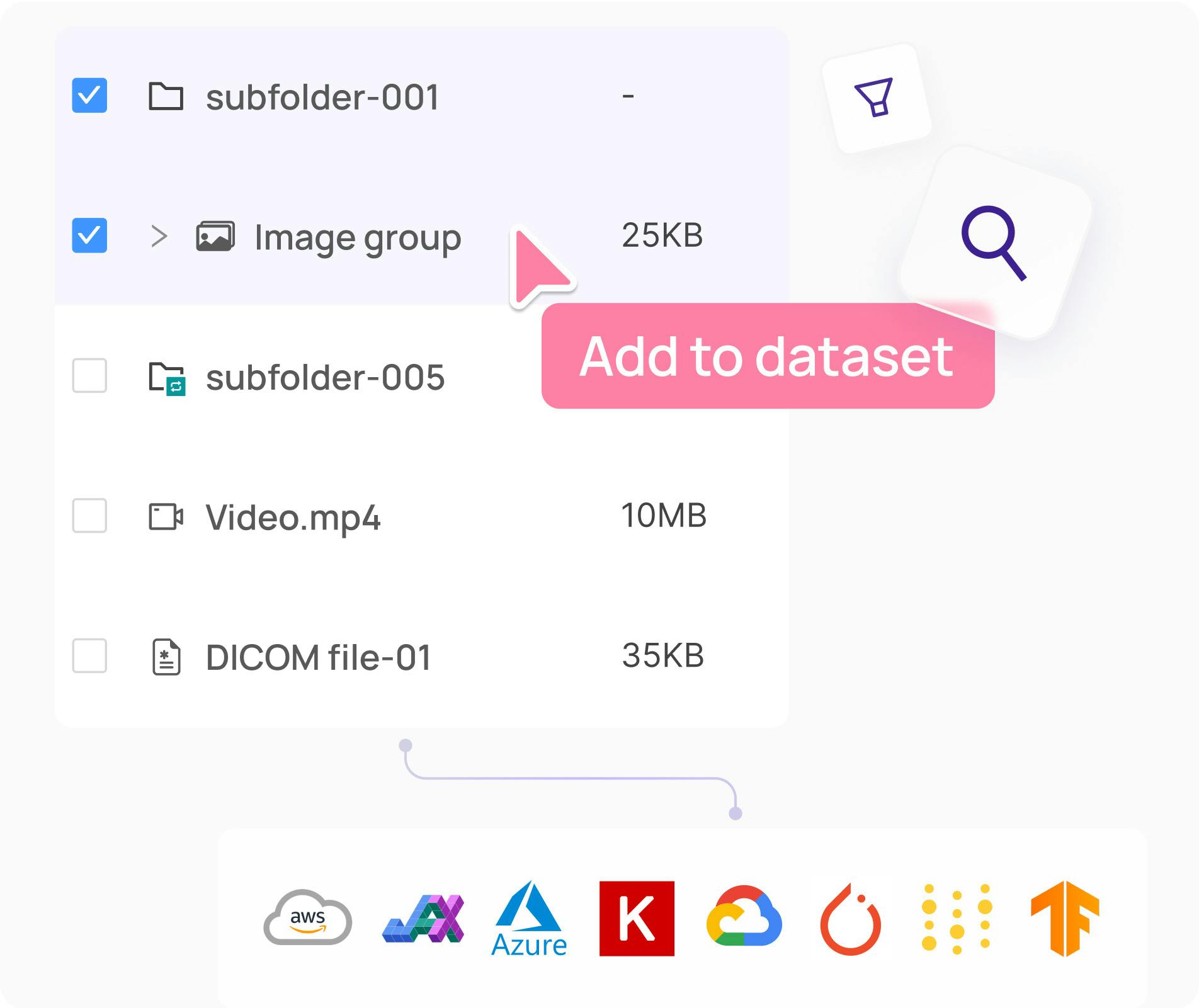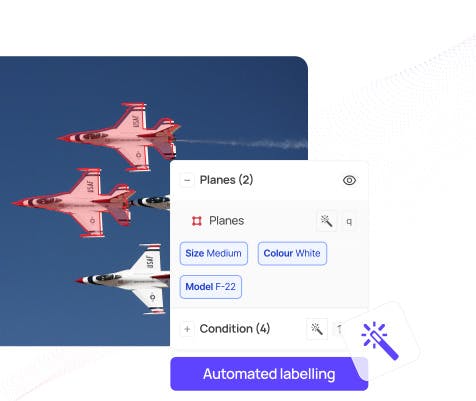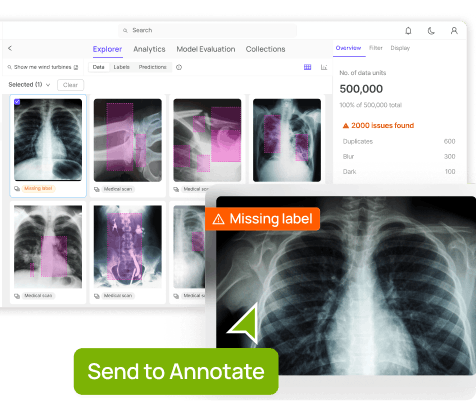Contents
What Is a Data Labeling Platform?
Why Data Labeling Platforms Matter for GenAI
Data Labeling Platforms for GenAI Summarized
Top 7 Data Annotation & Labeling Platforms for GenAI
How to Choose the Right Data Labeling Platform for GenAI
Final Thoughts: What’s the Best Data Labeling Platform for GenAI in 2025?
Encord Blog
7 Best Data Labeling Platforms for Generative AI [2025]
5 min read

Encord is the top data labeling platform for Generative AI, built to handle multimodal datasets (text, image, video, audio, 3D, DICOM) and support LLM workflows like RLHF, dialog annotation, and red-teaming. With AI-assisted labeling, quality assurance, and enterprise-grade compliance, Encord powers secure, scalable GenAI data pipelines.
Generative AI models are only as good as the data they’re trained on. That means data labeling for GenAI isn’t just about bounding boxes or semantic segmentation. Rather it’s about curating instruction datasets, reinforcement learning data, multimodal alignment, fine-tuning corpora, and evaluation frameworks.
If you’re building for GenAI, you need data labeling platforms that can:
- Handle multimodal data (text, code, image, video, audio, 3D, medical)
- Support LLM-specific workflows like prompt-response labeling, red-teaming, and preference data collection
- Enable AI-assisted labeling (e.g., ChatGPT, SAM, Whisper integrations) to accelerate throughput
- Scale with secure, compliant infrastructure for enterprise-grade deployments.
- Provide quality assurance (QA) and workforce collaboration tools to ensure consistency across large GenAI datasets
Below, we compare the 7 best data labeling platforms for GenAI teams in 2025, focusing on their relevance to LLMs, multimodal foundation models, and applied GenAI.
What Is a Data Labeling Platform?
A data labeling platform is software that enables teams to annotate, manage, and curate data for AI model training. In Generative AI, this includes text, images, video, audio, and 3D data used to fine-tune LLMs and multimodal models. Advanced platforms—like Encord—also support AI-assisted labeling, reinforcement learning from human feedback (RLHF), red-teaming, workflow management, and compliance, helping organizations create high-quality, scalable datasets for enterprise-grade GenAI projects.
Why Data Labeling Platforms Matter for GenAI
Traditional CV annotation (bounding boxes, segmentation) still matters, but GenAI raises the stakes:
- LLMs need high-quality, structured, multilingual instruction datasets
- Multimodal models (text-to-video, speech-to-image) require aligned annotation across formats
- Reinforcement Learning from Human Feedback (RLHF) demands scalable preference labeling and fine-grained quality scoring
- Enterprise GenAI requires compliance, audit trails, and secure pipelines for sensitive data
Data Labeling Platforms for GenAI Summarized
| Platform | Modalities Supported | GenAI Features | Automation | Collaboration & QA | Compliance | Deployment |
| Encord | Images, video, text, audio, docs, 3D, DICOM | RLHF workflows, dialog annotation, red-teaming | SAM, GPT, CLIP-assisted labeling | Dashboards, workflows, workforce QA | SOC 2, HIPAA, GDPR | Cloud & private options |
| Snorkel Flow | Text, documents, structured data | Programmatic labeling, LLM evaluation | Labeling functions, weak supervision | Reviewer workflows, experiment tracking | Enterprise-ready | Cloud |
| BasicAI | Text, audio, image, speech, multimodal | RLHF pipelines, dialog scoring | Pre-labels, active learning | Feedback QA, consensus workflows | GDPR-ready | Cloud |
| V7 Labs | Images, video, text (light) | Multimodal dataset orchestration | Auto-segmentation, AI-assisted vision tools | Team workflows, dataset versioning | SOC 2 | Cloud |
| TrainingData | Images (CV focus) | On-prem annotation for secure projects | Limited automation | Reviewer roles, secure collaboration | Custom (local security) | On-prem (Docker) |
| SuperbAI | Images, video, point-cloud, docs | End-to-end ML lifecycle | Active learning, automation | Access controls, drift detection | SOC, AES-256 | Cloud |
| Kili Technology | Images, text, CV, NLP | ChatGPT/SAM integrations for assisted labeling | Pre-annotations, active learning | Lightweight roles & QA | GDPR, SOC 2 | Cloud |
| Labelbox | Images, video, audio, text, 3D | Experiment-driven workflows, model-assisted labeling | Pre-labeling, active learning | Consensus QA, role-based workflows | SOC 2, HIPAA, GDPR | Cloud |
Top 7 Data Annotation & Labeling Platforms for GenAI
Here’s how the leading platforms stack up for generative AI use cases.
1. Encord – Enterprise-Grade Multimodal Labeling for GenAI
Why it’s #1 data labeling platform for GenAI: Encord goes beyond traditional labeling with full-stack data operations: annotation, management, model evaluation, and QA. It’s built for multimodal and regulated domains (healthcare, physical AI, enterprise LLM pipelines).
- Supports instruction datasets for LLMs and multimodal data (text, video, DICOM, point cloud, audio)
- Model-assisted labeling with SAM, GPT, and interpolation
- Scales to millions of labels per project with enterprise security (GDPR, SOC 2, HIPAA)
- Custom QA workflows for RLHF, red-teaming, and eval loops
Best for: Organizations that need a secure, compliant, and enterprise-scale platform for multimodal GenAI projects in fields like healthcare, robotics, and physical AI.

2. Snorkel Flow – Programmatic Labeling Meets GenAI Evaluation
Snorkel Flow pioneered programmatic labeling (weak supervision) and has now extended its platform for generative AI. It’s especially strong for teams who want to combine human-in-the-loop labeling with automation.
Key features:
- Programmatic labeling: create labeling functions instead of labeling each example by hand
- GenAI evaluation tools: rank model generations, compare multiple LLMs, and annotate multi-schema dialog data.
- Rapid dataset iteration: adjust rules/labeling functions and re-label datasets instantly without re-annotating.
Best for: teams running LLM fine-tuning and evaluation pipelines where speed + automation are critical.

3. BasicAI – LLM & RLHF Dataset Platform
BasicAI focuses squarely on LLM and GenAI datasets, making it a strong choice if your priority is dialog data, SFT (supervised fine-tuning), or RLHF.
Key features:
- Dialog annotation tools: rank, score, and compare LLM responses across multiple turns
- RLHF workflows: integrated pipelines for preference modeling, response scoring, and feedback QA
- Dataset governance: track versions, assign roles, manage reviewer consensus, and export for fine-tuning.
Best for: companies aligning LLMs with human values, especially in chatbots, copilots, or assistants.
4. V7 Labs – Collaborative Dataset Platform
V7 Labs is a SaaS platform designed for collaborative annotation and dataset management. It’s widely used for computer vision but increasingly supports multimodal tasks relevant to GenAI.
Key features:
- Dataset orchestration: organize, version, and search datasets at scale with a built-in catalog
- Workflow automation: create pipelines where data moves through labeling, QA, and model-assisted stages
- Cloud-native collaboration: supports large teams, integrates with GCP, AWS, and Azure storage.
Best for: GenAI teams working heavily with vision + multimodal models that require fast iteration and teamwork.

5. TrainingData – Private, On-Prem Annotation
TrainingData is a self-hosted annotation platform built for companies that prioritize data sovereignty and compliance. Unlike cloud-first providers, it runs entirely inside your infrastructure.
Key features:
- Pixel-accurate tools: polygon, brush, and keypoint annotation for precise CV tasks
- On-premise deployment: delivered as a Docker container that runs securely behind your firewall
- Regulated use cases: tailored for industries like healthcare, defense, and finance
Best for: regulated industries needing private, compliant annotation with no external data transfer.
6. Kili Technology – Lightweight GenAI Data Tool
Kili is a lean but flexible annotation platform that’s particularly well-suited for NLP and LLM tasks. It focuses on making labeling accessible while offering automation hooks.
Key features:
- Text and vision support: NER, OCR, classification, sequence labeling, and segmentation
- GenAI integrations: connect to models like ChatGPT or SAM for assisted labeling
- Dataset export: ready-made formats for LLM fine-tuning pipelines
Best for: LLM startups and research groups needing a nimble, easy-to-set-up GenAI annotation platform.
7. Labelbox – Flexible Platform for Iterative AI Development
Labelbox is a versatile data labeling and management platform designed to help teams experiment, iterate, and improve datasets quickly. It’s particularly useful for teams that want to connect labeling tightly with experimentation cycles.
Key features:
- Broad modality support: text, images, audio, video, and 3D data
- Model-assisted labeling: integrate foundation models for pre-labeling and correction loops
- Experiment-driven workflows: dataset versioning, active learning loops, and consensus-based QA for rapid iteration
Best for: AI teams who value speed, flexibility, and rapid experimentation, particularly startups and research labs refining their LLM or CV datasets.
How to Choose the Right Data Labeling Platform for GenAI
| Need / Use Case | Best Choice(s) |
| Enterprise-scale, regulated, multimodal projects | Encord |
| Rapid dataset iteration & weak supervision | Snorkel Flow |
| LLM alignment & RLHF pipelines | BasicAI, Encord |
| Collaborative vision datasets | V7 Labs |
| On-prem / highly secure environments | TrainingData |
| End-to-end ML workflow integration | SuperbAI |
| Lightweight GenAI startups | Kili Technology |
| Fast experimentation & iteration cycles | Labelbox |
Final Thoughts: What’s the Best Data Labeling Platform for GenAI in 2025?
While every platform here brings something unique to the table, Encord stands out as the most complete data labeling solution for generative AI in 2025. Unlike tools that focus narrowly on annotation, Encord is a full-stack data operations platform, covering annotation, dataset management, QA, evaluation, and compliance in one place.
This matters for GenAI because building powerful models isn’t just about labeling data, it’s about creating high-quality, multimodal datasets at scale, ensuring regulatory compliance, and running feedback loops like RLHF that align AI with human expectations.
For organizations that need a trusted, enterprise-grade partner to power GenAI data pipelines 👉 Try Encord.
Explore the platform
Data infrastructure for multimodal AI
Explore product
Explore our products
- Generative AI models rely on high-quality datasets for training. Unlike traditional CV tasks, GenAI requires instruction datasets, multimodal alignment, RLHF (Reinforcement Learning from Human Feedback), and evaluation frameworks. Precise labeling directly impacts model safety, accuracy, and performance.
- Encord is more than just an annotation tool—it’s a full-stack data operations platform. It supports multimodal data (text, video, images, audio, 3D, medical formats) and GenAI-specific workflows like prompt-response labeling, RLHF, red-teaming, and evaluation loops. With enterprise-grade compliance and scalability, Encord helps teams build production-ready GenAI models faster.
- Yes. Encord provides custom QA workflows for RLHF, including preference data collection, scoring, and red-teaming. These workflows are critical for aligning LLMs and multimodal models with human values and safety requirements.
- Absolutely. Encord supports images, video, audio, text, documents, point cloud, DICOM, and 3D data. This makes it ideal for building multimodal foundation models, such as text-to-video, speech-to-image, or robotics applications.
- Yes. Encord complies with GDPR, SOC 2, and HIPAA standards, while offering advanced encryption and access controls. It is trusted in sensitive industries like healthcare, robotics, and physical AI, where compliance and audit trails are non-negotiable.
- Yes. Encord integrates with SAM, GPT-based models, and Whisper to accelerate annotation throughput. These AI-assisted tools reduce manual effort while maintaining high label quality.


